Top 10 Ways to Fix ‘Display Driver Failed to Start’ Error in Windows 10 and 11
Display drivers facilitate communication between the Windows operating system (or any OS) with your GPU. But if the display driver encounters an issue, you will see unexpected errors like the ‘Display Driver Failed to Start’ error.
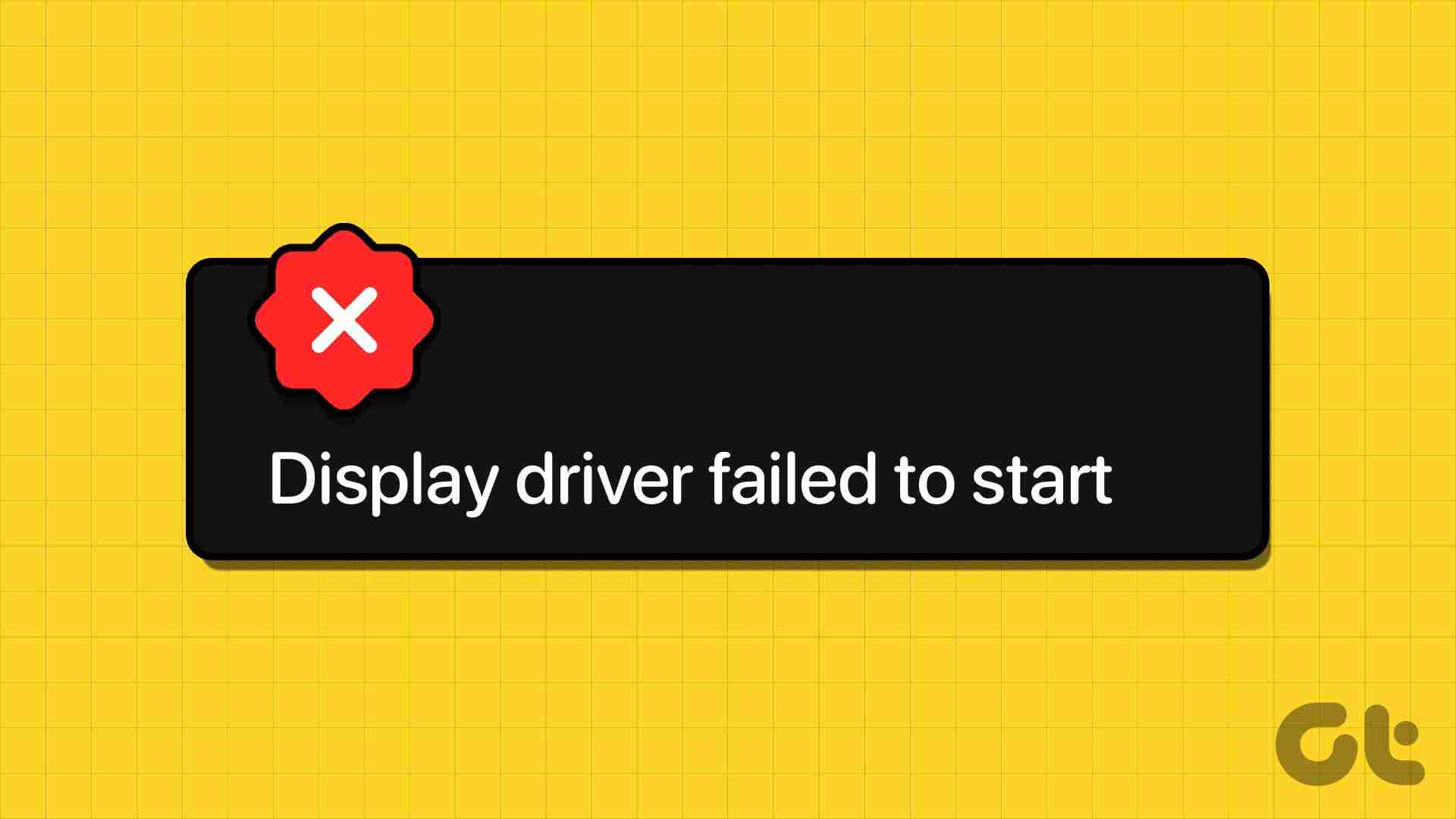
Notable reasons behind this error include problematic connections, outdated or corrupt drivers, registry issues, and hardware problems. Try these ten methods to resolve the error and make the graphics card run flawlessly.
1. Restart Graphics Drivers
Before diving into more advanced fixes, restart your Windows PC’s graphics drivers. This method applies to all GPU manufacturers so that it will work in PCs with NVIDIA, AMD, or Intel GPUs.
Press the Windows + Ctrl + Shift + B keyboard shortcut at once to initiate the restart. Your screen will flicker and might even go dark for a few seconds. After that, the display will reappear.
If you use an external display with a laptop, the external display connection will not be restored after the restart. You will have to open the Settings app and reconfigure to extend or duplicate the screen on the external display.
2. Use a Powered VGA-USB Adapter
The ‘display driver failed to load’ error causes Windows to switch to the basic display driver. However, if you use a basic VGA-USB adapter to connect an external monitor via USB, you must switch to a powered VGA-USB adapter. This is because newer GPUs do not support the VGA standard.
So, if you need to connect to a monitor with old input options like VGA, use a powered VGA-USB adapter. Also, inspect all the physical cable connections of the components, including the GPU.
3. Update the Graphics Card Driver
Outdated and corrupt drivers can produce errors and poorly work with newer OS updates. So, you must update them using Device Manager. Here’s how:
Step 1: Press the Windows key + X shortcut to open the Power User menu. Click on the Device Manager option.
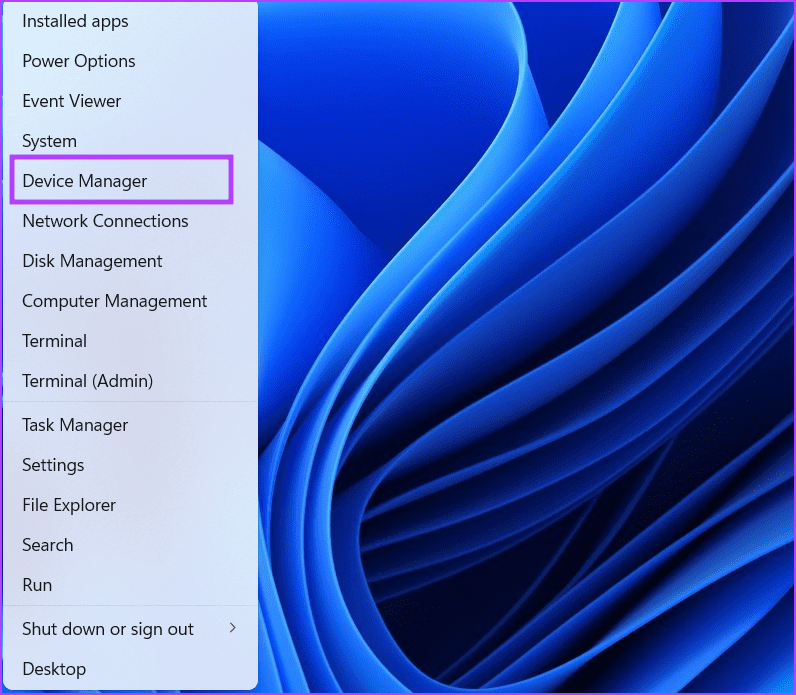
Step 2: Click on the Display adapters option. Then, right-click on the GPU name and select the Update driver option.
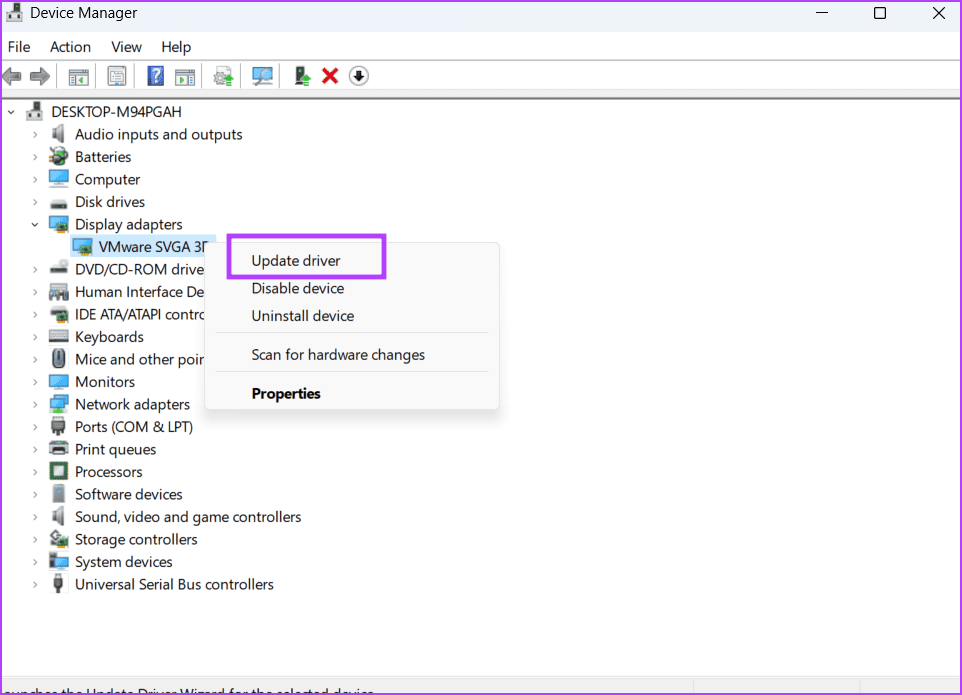
Step 3: Click on the ‘Search automatically for drivers’ option. Wait for it to download and install the latest GPU drivers for your PC.

Step 4: Close the Device Manager.
4. Run the Hardware and Devices Troubleshooter
Hardware and Devices Troubleshooter can identify and fix issues with your PC. Microsoft intends to remove the tool, but you can still access it using Command Prompt. Here’s how:
Step 1: Press the Windows key to open the Start menu. Type cmd in the search box and simultaneously press Ctrl + Shift + Enter keyboard shortcut.

Step 2: The User Account Control window will launch. Click on the Yes button to open the Command Prompt with admin privileges.
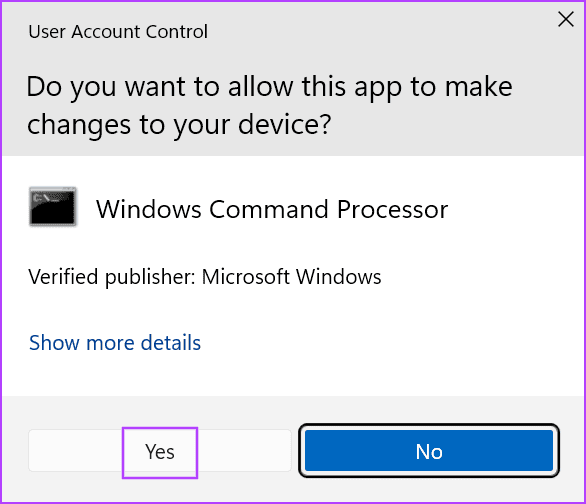
Step 3: Type the following command and press Enter to launch the Hardware and Devices troubleshooter:
<code>Msdt.exe -id devicediagnostic</code>
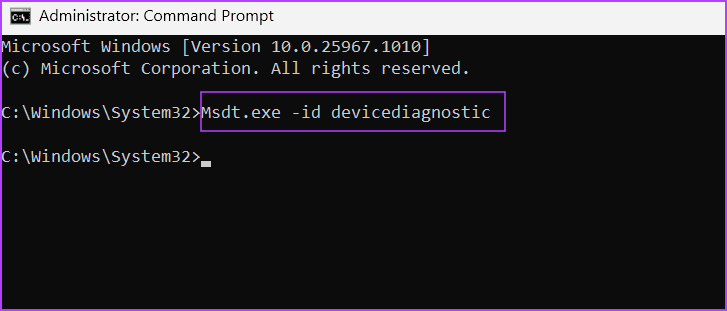
Step 4: Click on the Next button.
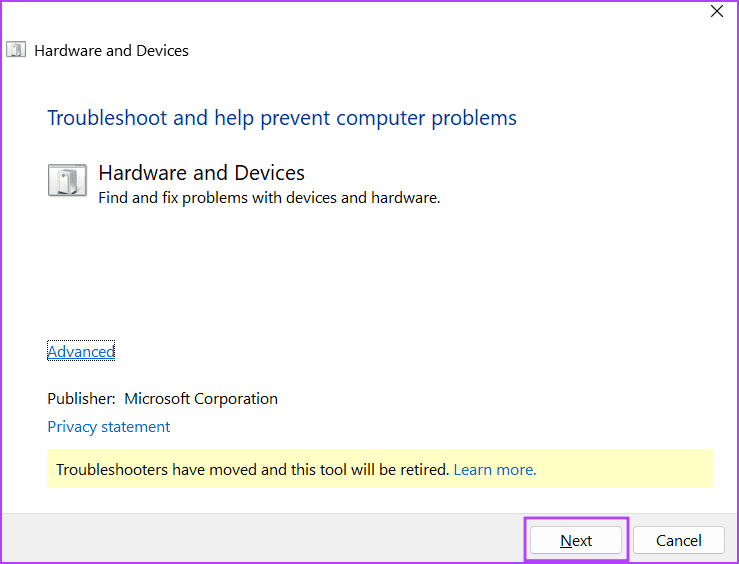
Step 5: Wait for the utility to identify and automatically fix problems on your PC.
Step 6: Close the troubleshooter window.
5. Tweak Windows Performance Settings
You must change the Windows Performance settings to fix your PC’s ‘display driver failed to load’ issue. This method worked wonders for some users whose Desktop Window Management program crash was the reason behind the display driver problem. Here’s how:
Step 1: Press the Windows key to open the Start menu. Type the following command in the search box and press Enter to launch the advanced setting window:
<code>%windir%\system32\SystemPropertiesPerformance.exe</code>
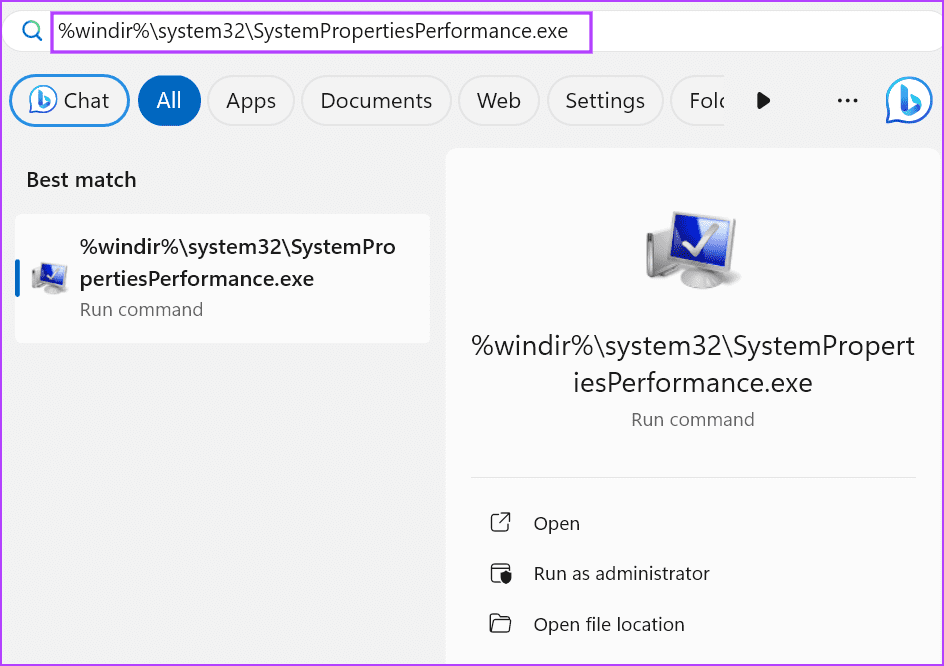
Step 2: Click on the ‘Adjust for best performance’ radio button.
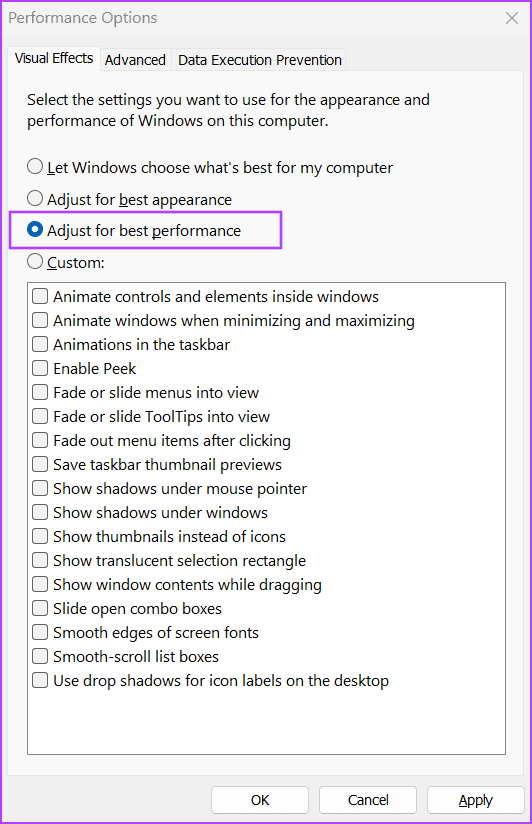
Step 3: Click on the Apply button and then click on the OK button.
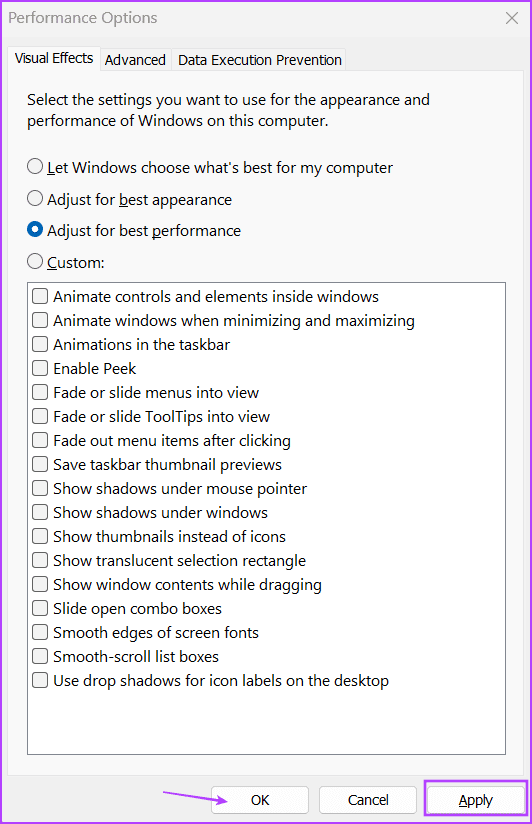
Step 4: Restart your PC.
6. Remove Graphics Card Driver Using DDU and Manually Reinstall
If updating the graphics card drivers and running the hardware and devices troubleshooter doesn’t have any effect, and you still see the ‘failed to initialize display adapter’ error, you must remove and reinstall the GPU drivers. For this, you can use the Display Driver Uninstaller (DDU) tool, which wipes all the remnant files related to the GPU drivers. Here’s how:
Step 1: Download the portable version of the Display Driver Uninstaller (DDU) tool.
Step 2: Extract the tool and launch it using the executable file. When the User Account Control window pops up, click on the Yes button.

Step 3: Click on the Select device type drop-down list. Then click on the GPU option.
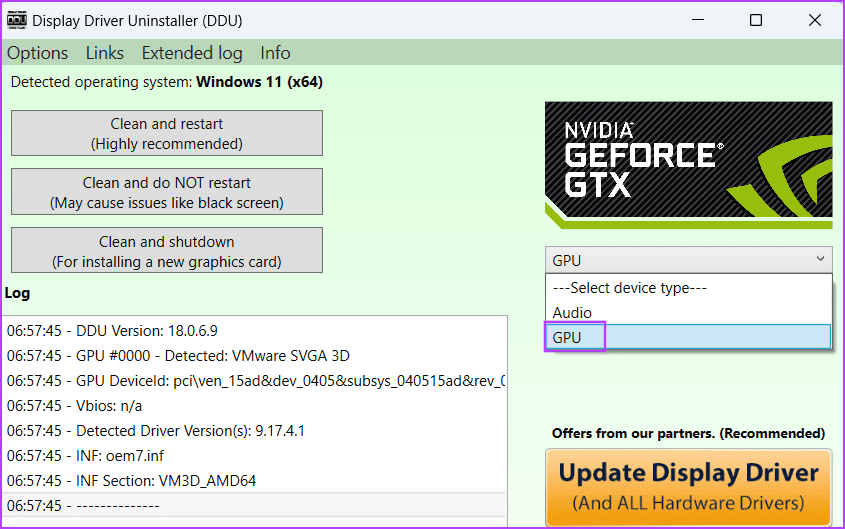
Step 4: Click on the device drop-down list to expand it. Select your GPU name in the list.
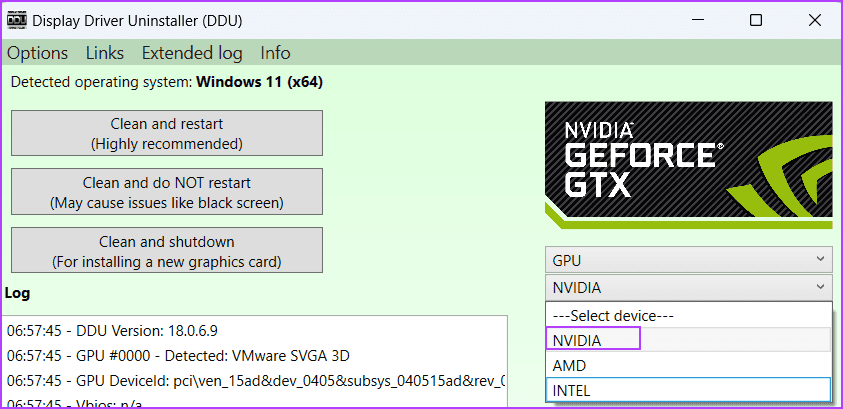
Step 5: Click on the Clean and restart option.

Step 6: Display Driver Uninstaller will start the GPU driver removal process and restart your PC.
Download the latest version of the graphics drivers from your GPU manufacturer’s website and install it on your PC.
7. Modify the System Registry
You can modify the TDR values to resolve this bothersome graphics driver in Windows 11. This change will make Windows wait longer for a response from the GPU. But before doing that, create a registry backup and export it to an external storage drive. Then, repeat the following steps:
Step 1: Press the Windows key to open the Start menu. Type cmd in the search box and simultaneously press Ctrl + Shift + Enter keyboard shortcut.

Step 2: The User Account Control window will open. Click on the Yes button to launch the Command Prompt with admin privileges.

Step 3: Type the following command and press Enter to set a timeout of 60 seconds:
<code>reg add "HKEY_LOCAL_MACHINE\SYSTEM\CurrentControlSet\Control\GraphicsDrivers" /v TdrDelay /t REG_DWORD /d 60 /f</code>
Step 4: Execute the following command to increase the time before Windows throws a bug-check:
<code>reg add "HKEY_LOCAL_MACHINE\SYSTEM\CurrentControlSet\Control\GraphicsDrivers" /v TdrDdiDelay /t REG_DWORD /d 60 /f</code>
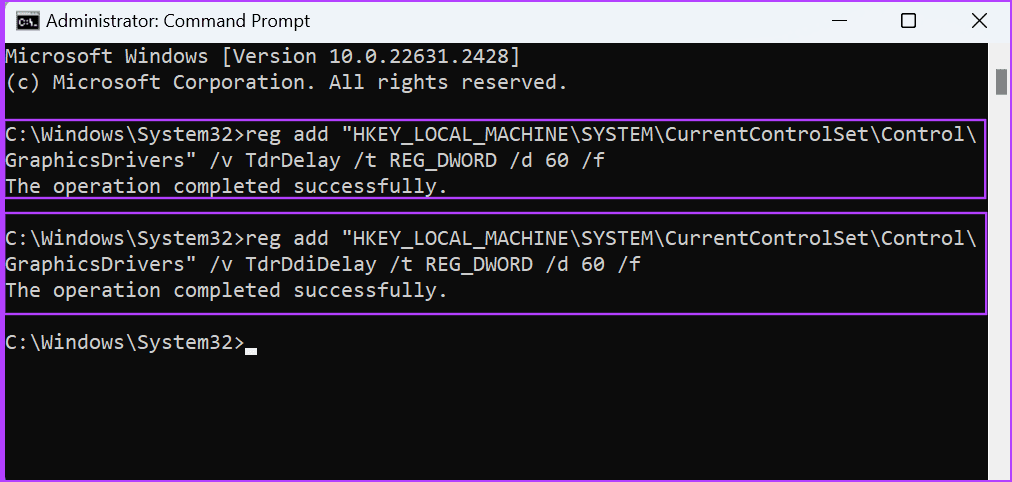
Step 5: Close the Command Prompt window and restart your PC.
8. Use System Restore
If modifying the registry failed to impact the error, try applying a System Restore point. Here’s how:
Step 1: Press the Windows key to open the Start menu. Type rstrui in the search bar and press Enter to open the System Restore window.
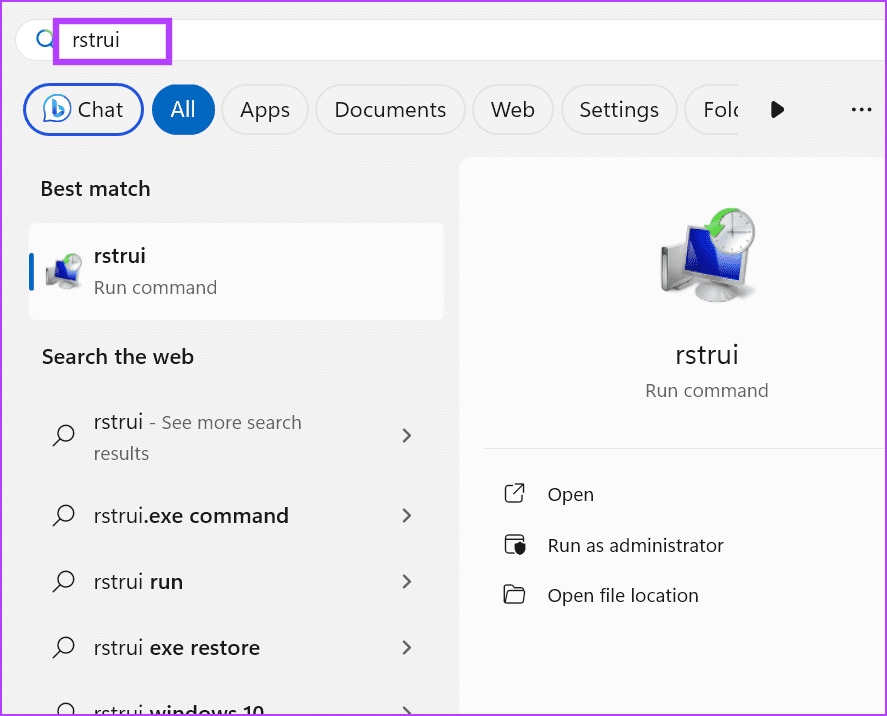
Step 2: Click on the Next button.
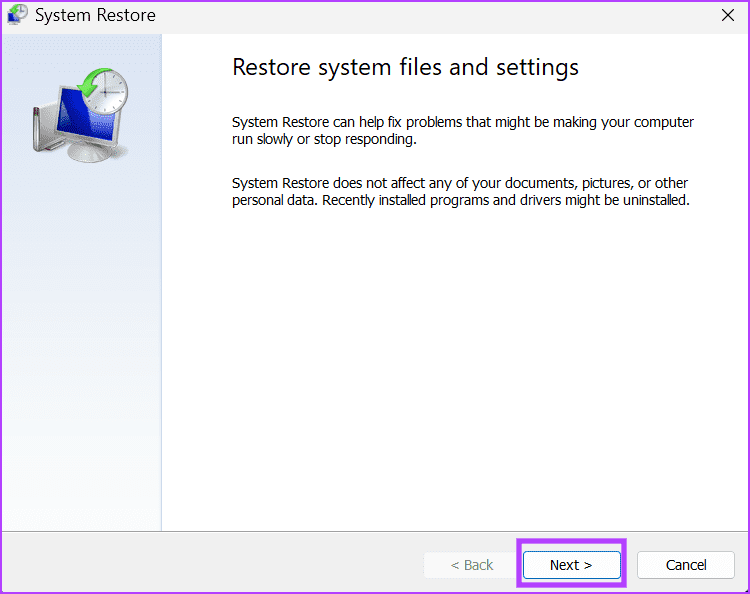
Step 3: Pick a restore point from the list and follow the on-screen instructions to apply the restore points on your PC.
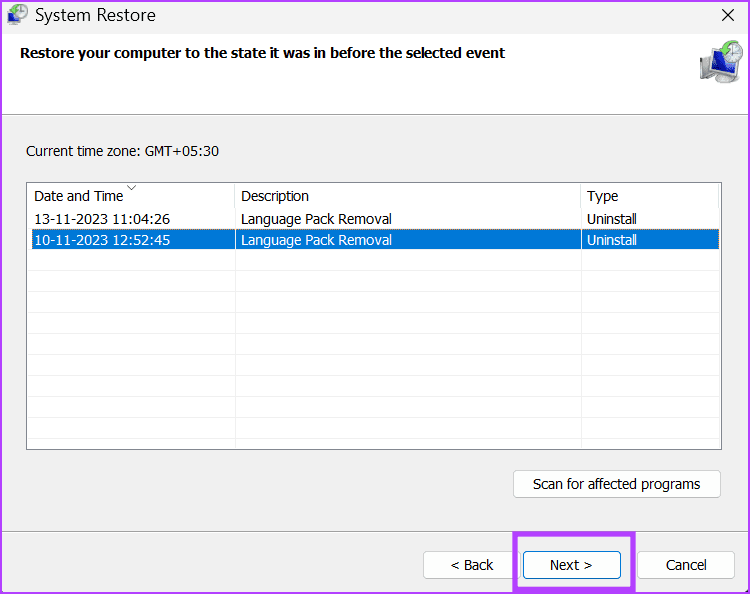
9. Reset Your PC
Performing an In-place Upgrade is a great way to keep all the personal files and installed apps. But since it will keep the installed drivers, it is better to reset your PC. You can choose to save the personal files but will have to install the GPU drivers and all other programs manually. Here’s how to do it:
Step 1: Press the Windows key to open the Start menu. Type reset this pc in the search bar and press Enter to open the Settings app.
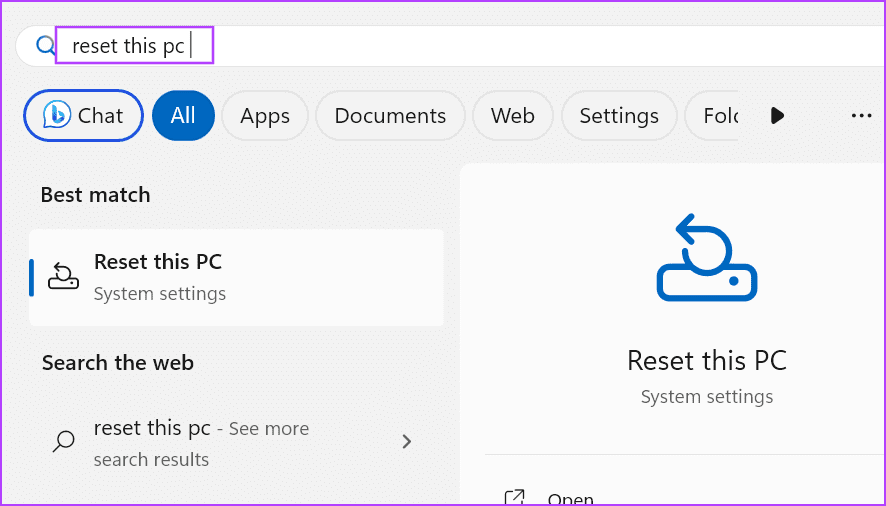
Step 2: Go to the Recovery options section. Click on the Reset PC button.
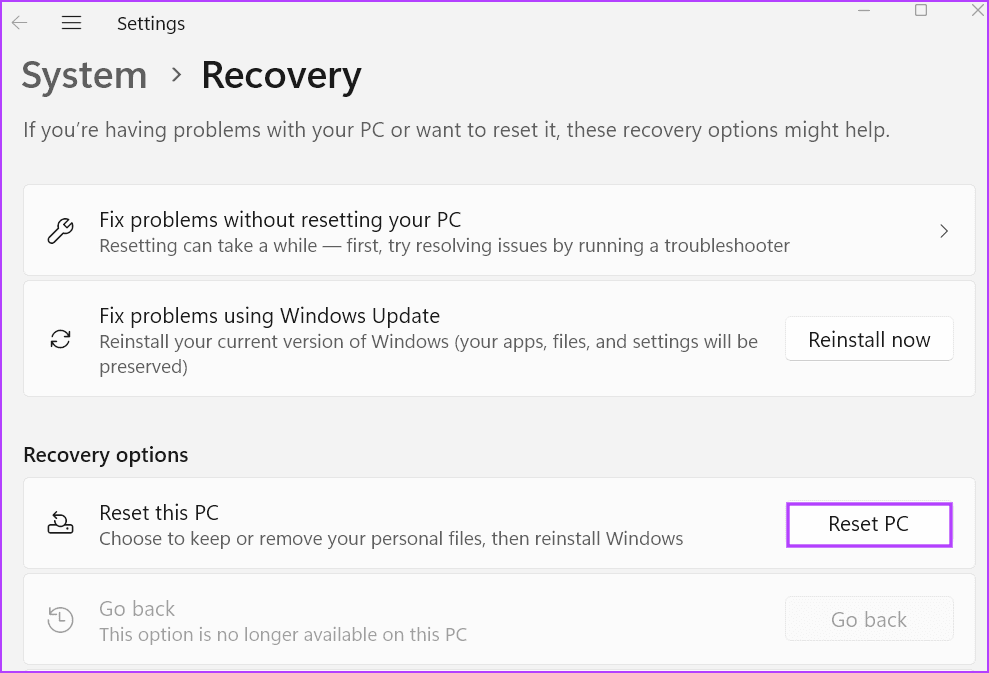
Step 3: Select the Keep my files in the Reset this PC window to save your personal files from deletion.

Follow the on-screen instructions to begin the reset process. Your PC will restart several times to reinstall Windows and boot to the lock screen.
After logging in, download and install all the system drivers from your OEM manufacturer’s website or using the driver disk or ISO file provided by your manufacturer. In the case of a custom PC, you must download drivers for each component separately.
10. Get Your GPU and PSU Checked
After exhausting all the software-related fixes, if you still face the display driver issue, it’s time to get the GPU inspected by a technician for hardware defects. Some users also face issues due to a weak or faulty power supply unit, so ensure get that checked and replaced, if required.
Fix GPU Issues
These were the ten methods to fix the ‘Display Driver Failed to Start’ error in Windows 10 and 11 PCs. Restart GPU drivers, inspect physical connections, and use a powered VGA-USB adapter. After that, update or reinstall the drivers, adjust the Windows performance settings, and modify the system registry. Lastly, do a system reset and replace faulty hardware.
以上是Top 10 Ways to Fix ‘Display Driver Failed to Start’ Error in Windows 10 and 11的详细内容。更多信息请关注PHP中文网其他相关文章!
 通过AI生成的PowerShell脚本自动重复任务 - 使技术更容易May 16, 2025 am 02:35 AM
通过AI生成的PowerShell脚本自动重复任务 - 使技术更容易May 16, 2025 am 02:35 AM我一直认为计算机应该为我们服务,而不是相反。当我发现自己专注于重复任务时,对这种信念进行了测试。但是,当我开始利用人工智能(ai)t时,情况发生了变化
 如果您的Microsoft帐户上的活动中有不寻常的迹象,该怎么办May 16, 2025 am 02:34 AM
如果您的Microsoft帐户上的活动中有不寻常的迹象,该怎么办May 16, 2025 am 02:34 AM与其他大型公司类似,Microsoft优先考虑您的帐户安全性和保护有害意图的个人未经授权的访问权限。如果Microsoft检测到异常的登录尝试,则将其标记为可疑。您会收到一个
 如何在Windows中回滚驱动程序 - 使技术更容易May 16, 2025 am 02:33 AM
如何在Windows中回滚驱动程序 - 使技术更容易May 16, 2025 am 02:33 AM在Windows系统中,驱动程序问题是相当常见的。有时候,新驱动程序的更新可能会在Windows中引发蓝屏死机(BSOD)错误信息。幸运的是,通过回滚驱动程序可以解决这个问题。您可以使用回滚驱动程序功能将驱动程序更新还原到之前的版本,以检查其是否正常运行。以下是如何在Windows中回滚驱动程序的详细指南。目录在Windows中回滚驱动程序如果回滚驱动程序选项被禁用怎么办?常见问题解答在Windows中回滚驱动程序Windows自带了一些专为检测和解决操作系统可能出现的冲突而设计的内置工具。这包
 如何获得Windows注册表键的全部所有权 - 使技术更容易May 16, 2025 am 02:28 AM
如何获得Windows注册表键的全部所有权 - 使技术更容易May 16, 2025 am 02:28 AMWindows注册表是存储与Windows操作系统及其软件相关的所有配置的中心枢纽。这就是为什么许多Windows教程通常涉及添加,修改或删除注册表键。
 如何删除Windows 11中的'系统需求”水印 - 使技术更容易May 16, 2025 am 02:27 AM
如何删除Windows 11中的'系统需求”水印 - 使技术更容易May 16, 2025 am 02:27 AMWindows 11确实有严格的安装要求。然而,在不支持的设备上安装Windows 11并非难事。如果您成功安装了,请不要急于庆祝。您还需要清除微软为阻止在不支持的硬件上安装而引入的桌面“系统要求未满足”水印。本指南列出了三种方法来去除此水印。目录组策略编辑器Windows注册表编辑器脚本组策略编辑器如果您使用的是Windows Pro或Enterprise版,并且启用了组策略编辑器,此方法最为简单。按照以下说明通过组策略编辑器禁用水印。在Windows搜索中输入“组策略”,并点击结果中的编辑组
 Microsoft Teams Camera无法正常工作?了解如何解决May 16, 2025 am 02:22 AM
Microsoft Teams Camera无法正常工作?了解如何解决May 16, 2025 am 02:22 AMMicrosoft团队是一个广泛使用组织内部协作和沟通的平台。尽管它有效,但您偶尔在通话过程中可能会面对相机的问题。本指南提供了一系列解决方案来解决
 如何在Windows中检查RAM类型 - 使技术更容易May 16, 2025 am 02:21 AM
如何在Windows中检查RAM类型 - 使技术更容易May 16, 2025 am 02:21 AM如果您计划升级您的RAM或测试其性能,了解您的RAM类型非常重要。这意味着需要评估您的笔记本电脑或PC以确定它支持的DDR模块,以及其他细节,如RAM的形式、速度和容量。本教程将展示如何在Windows中使用各种Windows应用和第三方工具来检查RAM类型。目录通过命令提示符检查RAM类型通过任务管理器在Windows中检查RAM类型在PowerShell中检查RAM类型使用CPU-Z检查RAM类型使用Novabench检查RAM类型通过目视检查主板来检查RAM类型通过命令提示符检查RAM类型
 如何在Windows上修复'地方安全局保护” - 使技术更容易May 16, 2025 am 02:20 AM
如何在Windows上修复'地方安全局保护” - 使技术更容易May 16, 2025 am 02:20 AM地方安全局(LSA)保护是一项至关重要的安全功能,旨在保护用户在Windows计算机上的凭据,从而防止未经授权的访问。一些用户遇到了一条错误消息,指出“本地安全A


热AI工具

Undresser.AI Undress
人工智能驱动的应用程序,用于创建逼真的裸体照片

AI Clothes Remover
用于从照片中去除衣服的在线人工智能工具。

Undress AI Tool
免费脱衣服图片

Clothoff.io
AI脱衣机

Video Face Swap
使用我们完全免费的人工智能换脸工具轻松在任何视频中换脸!

热门文章

热工具

禅工作室 13.0.1
功能强大的PHP集成开发环境

SublimeText3汉化版
中文版,非常好用

Dreamweaver CS6
视觉化网页开发工具

VSCode Windows 64位 下载
微软推出的免费、功能强大的一款IDE编辑器

ZendStudio 13.5.1 Mac
功能强大的PHP集成开发环境






